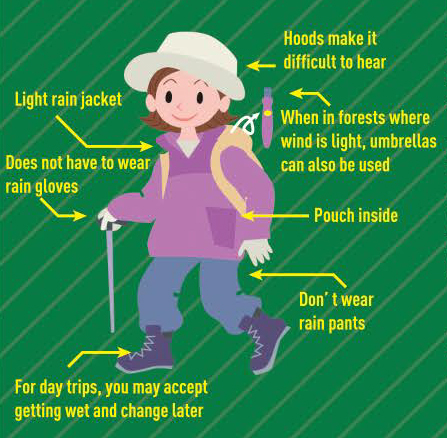Notes on climbing Mt.Oyama
Guidelines
・Plan a schedule that suits your hiking abilities.
・Bring spare shirts, outerwear and other gear to correspond with change of temperatures.
・Take your time. Do not try to rush up the mountain. Taking small steps when travelling up steep inclines can help you to avoid exhaustion. Remember to take a break each hour.
・Remember to mind your manners. Let ascending climbers go first in narrow sections, keep to the mountain face when waiting, be friendly and courteous, and share any important information with other hikers.
・Do not litter. Bring all garbage back with you when you leave.
Caution
・Weather on the mountain is subject to sudden change.
Mt. Oyama is also known as Afuriyama / Amefuriyama, which means ‘ the rainy mountain.’ Rain often falls on the mountain even when the weather seems clear below. Remember to pack rain gear.
・Use toilets when available.
Toilets are scarce along the mountain. Check their locations in advance. Be advised that toilets in some areas, such as the mountain summit, may not be available in winter.
・Create a flexible hiking plan.
Falling rocks, rookslides and other accidents can occur while hiking. Submit a hiking plan before embarking on your hike. Post boxes are located by principal starting points and in the nearby parking lot.
・Check last times for public transportation.
Be advised that the last time for cable cars and some buses is fairly early. If descending the mountain after dark, use a flashlight and watch your step.
・Snow and ice can accumulate in winter.
Use climbing irons, climbing boots, walking sticks and other safety equipment. Paths can be difficult to see when snow has accumulated. Check maps carefully before climbing. Be advised that when temperatures rise, melting ice and snow can create slippery slush and mud.
Wild animals that inhabit the mountain
・Wild animal such as bears. deers and monkeys can be found on the mountain. Carry a bell or similar noisemaker to alert nearby animals to your presence and scare them away.
・Never feed any wild animals. Additionally, bring all leftover food and scraps with you when you leave.
・Fences are in place in some areas to keep wild animals from passing through and causing damage. If you pass through one of the gates on these fences, be sure to close it behind you.
・Be careful of land leeches. To avoid being bitten by leeches, wear socks and high boots, avoid openings in clothing and bare skin, and carefully apply repellant. Leech bites are most common from April through October, especially on days when temperatures reach around 25 degrees and humidity levels reach around 70%. Special caution should be taken during these times.
Hiking equipment
Knapsack: Choose one suited to your stature.
Rainwear: Bring rainwear even if weather appears clear.
Change of clothes/cold weather gear: Bring gear to correspond to changes intemperature.
Hat/sunglasses: Protection against ultra-violet rays.
Trekking shoes: Wear sturdy-soled shoes.
Climbing poles: To help avoid tired legs.
Climbing irons: Necessary in winter.
Headlamps: Also flashlights are ok.
Food and drink: Bring ample water, and high-calorie foods that are easy to carry and consume.
Map/compass: Transparent maps are best.
Toilet paper: Paper should be water soluble.
Health insurance documentation: Bring a copy of your national health insurance card or other health insurance documentation.

